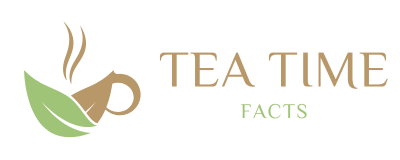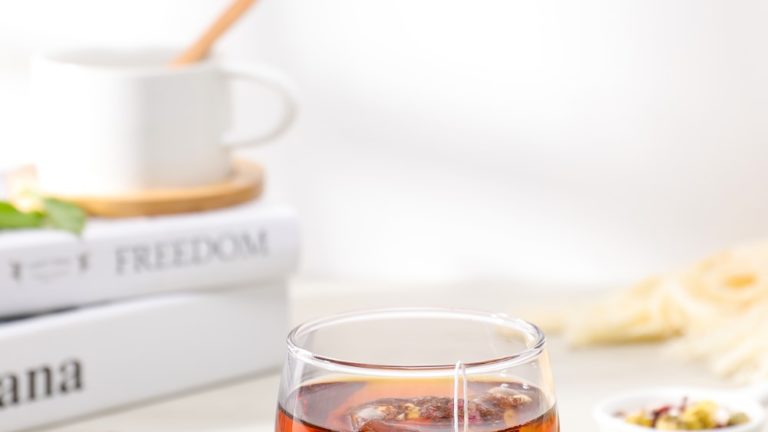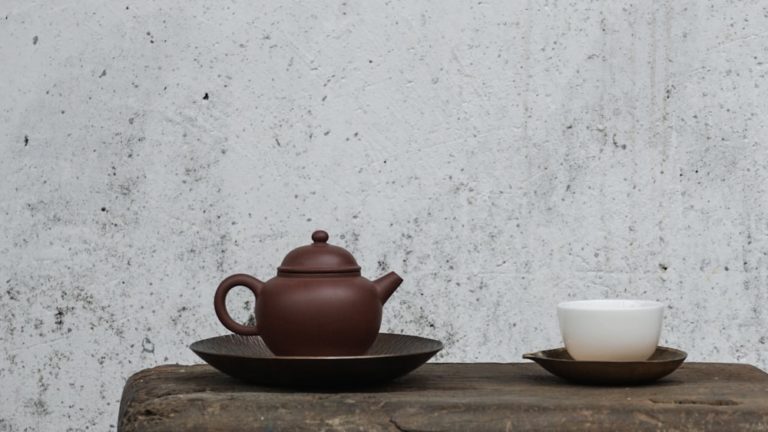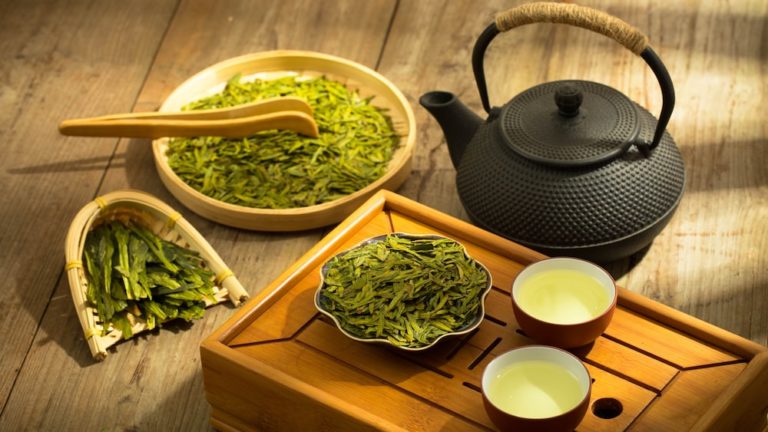Why Does Milk Curdle In Tea? The Science Behind It

Why Does Milk Curdle In Tea? The Science Behind It
Image this: You wake up early, still yawning and wishing you could hit the snooze button one more time. As you embrace the chill of the cold morning air, you decide to make yourself a much-needed hot cup of tea, with milk, of course. But alas, that is when the horror unfolds before your eyes! Just as you pour your freshly heated milk into that delicate blend of tea leaves… it curdles! It’s natural to feel like you’ve just stepped into a low-budget horror movie. But why does milk do this little death dance in your tea?
Well, dear readers, as it turns out, there’s a whole science to it. Yes, you heard it right, a science to why your morning brew sometimes looks like the cloudy realms of a tempest in a teacup. So, buckle up tea-enthusiasts, as we dive in to unravel the mystery behind the curdling conundrum. This is the tale of the tea and milk tango gone wrong.
Oh, and don’t worry, we won’t be turning your whole life “upsteeped” – we promise to help you in saving your future cups of tea from such milky mishap! So, shall we jolly well proceed?
The Science Behind Milk Curdling in Tea
If we were playing the ‘why game’, it would all start with proteins. Proteins, you ask? Yes, the very same we often associate with muscle growth and hair health. But how the Dickens did proteins sneak their way into this tea-meets-milk saga? Let’s dive in, shall we?
Understanding the Process of Curdling
Curdling, my fellow tea lovers, is like the squabbles you see in a kindergarten playground. But instead of children, imagine it’s the proteins in milk causing the ruckus. When these proteins are in their natural, calm state, they happily repel each other (because much like high school teenagers, they need their “space”).
However, the moment your milk gets into a hot tea splash zone, the heat agitates these proteins, who now start clinging together like love-bugs. And voila, you witness curdles taking shape, turning your once smoothe tea into a stormy seascape with milk-icebergs afloat.
When milk proteins are heated in tea, they agitate and cling together, resulting in curdles that ruin the smoothness of the tea.
The Role of Acidity in Curdling
But let’s not entirely blame heat for this dairy dispute, because there’s another villain lurking in the shadows of your cup – acidity. You see, most teas, especially the strong ones, happen to be acidic. And acidity, my friends, is to proteins what kryptonite is to Superman.
It causes the proteins to uncoil and clump together like fangirls at a boy band concert. What’s worse, when the acidity and heat join forces, they overthrow the peace in your milk protein kingdom, causing full-scale curdling. Our poor proteins, agitated and harassed, are left clinging to each other, creating that unpleasant, curdled spectacle we all despise in our tea!
Remember, dear readers, it’s not just about the temperature; acidity can trigger the curdling even before your milk has a shot at warming up. So pick your tea wisely – low acidity ones could save your milk from descending into a curdle carnival.
Factors Influencing Milk Curdling in Tea
As Sherlock Holmes would say, nothing happens without a reason. And milk turning into curdles in tea is no exception. It’s usually an unfortunate rendezvous involving factors like the heated jealousy of temperature and the acidic attitude of certain teas. But there’s more brewing in this milky mystery – let’s spill the tea, shall we?
The Temperature of the Tea
The hotter the tea, the higher are the chances of your milk transforming into an unappetizing mess. The proteins in milk, quite like us in a hot sauna, get stirred up by the high temperature. This results in curdling faster than you can say “cuppa tea”.
Talk about being hotheaded! If you’re one who dislikes watching your milk do a horror show in your tea, it’s time to rethink pouring milk into piping hot tea. Instead, let the tea cool down a bit before introducing it to its milky mate. Trust us, it’s a slight adjustment, but your tea will thank you for it.
So, the trick here is to remember that when it comes to temperature, it’s all about the balance. Sure, you want a hot cup of tea to shake away the morning blues, but you don’t want it to be so hot that it sends the milk proteins into a frantic frenzy!
The Freshness of the Milk
Ever noticed how fresh milk seems to get along with tea better than milk that’s suddenly decided it’s closer to its expiry date? The reason, dear tea drinkers, lies in the higher acidity levels of older milk. As the milk ages, bacteria works its magic fermenting lactose (milk sugar) into lactic acid. This mirthful microbial activity increases the acidity of your milk, making it more prone to curdling when it meets hot, often acidic, tea.
So, the fresher your milk, the less likely it is to curdle, you see? The moral of the story then – make sure you do your grocery shopping regularly, and that ‘milky way’ of yours might well lead to better, curdle-free tea experiences.

Different Types of Milk and Their Curdling Properties
When it comes to curdling, not all milks are created equal. Just like coffee beans, milk comes in different varieties, each with their distinct traits and quirks when introduced to your beloved cup of tea.
Cow’s Milk in Tea
As the usual and oh-so-mundane go-to for many tea enthusiasts, cow’s milk holds a notorious reputation in our curdling discussion. Most of us have witnessed this dairy diva perform her misunderstood dance, sprucing up our tea with unwanted lumpy guests – the curdles.
Somewhere across the rolling hills, the cows might be chuckling at our tea turmoil. Blame it on their milk’s high content of casein proteins, you see, which are rather sensitive to changes in acidity. When you pour in the tea, rich in tannins and embodying a lower pH, the stage jumps into a tango of acidity where the casein proteins curdle when they can’t carry the tangy tune.
But amid this curdle chaos, remember that tea temperature loves to have the last laugh. Too hot, and the curdling chances zoom. Ensure your tea is at a somewhat balmy temperature before welcoming in the cow’s milk.
Non-Dairy Milks in Tea
Ditching dairy and dancing with non-dairy milks in your tea can feel like venturing into treacherous territory. But fret not, friends, curdling can also occur with non-dairy substitutes.
Soy milk, the funky face of the plant milk movement, tends to curdle in the gleeful acidity of tea, thanks to its protein content. Almond milk, on the other hand, rarely curdles. Its low protein count makes it a safe bet to avert the dreaded curdling calamity, which is, in some ways, as unpredictable as a Monday morning coffee meeting.
Rice and oat milk both fall somewhere between soy and almond milk when it comes to curdling in tea. Their respective protein compositions determine their likelihood to form clumps when they meet your tea – just like an awkward interaction at a social gathering.
How to Prevent Milk from Curdling in Tea
Hold onto your teacups, dear reader, as the battle to banish the curdle doesn’t need to be lost! By following some simple steps, you can greatly reduce the chances of your milk throwing a curdled curveball right into your favorite steep.
Correct Order of Adding Ingredients
To pour the tea first or the milk? That is the age-old question that has sparked many a fireside debate among tea aficionados. The correct order of adding ingredients is crucial in sidestepping the curdled mess.
First off, avoid pouring hot tea directly onto cold milk. This temperature shock can swing the pH balance, summoning curdles in a heartbeat. Instead, try adding the milk first, and slowly follow it up with your brewed tea. This gradual meeting allows the milk to acclimate to the changing conditions and is less likely to result in curdling.
Second, consider the order of sugar or any sweeteners. It might not seem important, but sugar disrupts acidity balance and can subtly influence curdling. So, go easy on the sweet stuff and add it after the milk and tea rendezvous.
Adjusting the Temperature
For those who see milk curdling in tea as a house of horrors, here’s an interesting fact – the temperature at which you combine your tea and milk can play a significant role in avoiding this fright night!

Introducing cold milk to boiling tea is as disastrous as a winter swim in the Antarctica. The sudden hot-cold contrast creates a host of curdling conditions and ta-da, you’re left with a tea resembling a science experiment gone wrong! So, my friend, ensure your tea is sitting at a comfortable temperature before stepping onto this milky dance floor.
Also, warming the milk a little before setting it sailing into your tea can prevent curdling. Think of it as a ‘warm-up’ before the two ingredients meet. Literally.
Is it Safe to Drink Curdled Milk in Tea?
For those of you clutching onto your teacups in shock, here’s the silver lining. While curdled milk may seem as appealing as a coffee stain on a crisp white shirt, it’s usually safe to drink – a little lumpy unpleasantness won’t do you harm!
Health Implications of Consuming Curdled Milk
While curdled milk in tea might not appeal to your taste buds, it’s not typically detrimental to your health. Trust me, I’ve had my fair share of curdled milk lattes (unintentionally, of course)! It’s similar to consuming cheese or yogurt, which both result from the curdling process.
Now, don’t get me wrong: if the milk is spoiled before it curdles, then that’s a different kettle of fish altogether. Spoiled milk can contain harmful bacteria, leading to food poisoning. So, the bottom line is, if your milk was fresh when it curdled in your tea, you should be just fine. But if it was bad to begin with, you might need to spend less time sipping tea and more time sprinting to the bathroom, if you catch my drift!
If your milk was fresh when it curdled in your tea, you should be just fine, but if it was bad to begin with, you might need to spend less time sipping tea and more time sprinting to the bathroom.
FAQs
1. Why does milk curdle more in certain types of tea?
Certain types of tea, particularly those that are more acidic, cause milk to curdle more. The science behind this is pretty cool – or should I say, pretty acidic? The acidity of the tea interacts with the proteins in the milk, causing them to coagulate, a.k.a. curdle. In other words, your lemon tea might be more prone to turning into a curdled milk catastrophe than, say, your comforting chamomile.
2. Can curdled milk in tea make you sick?
Curdled milk in tea itself is not likely to make you sick unless it was already spoiling before it met our good friend Mr. Tea. That’s when harmful bacteria get in the game – or, more accurately, in your gut. As long as the milk was fresh when it curdled, though, you’re looking at a rather appalling cup of tea, rather than any serious health implications.
3. Is there a specific type of milk that doesn’t curdle in tea?
Indeed, a specific type of milk less prone to curdling is processed milks, like UHT or ultra-high temperature processed milk. These milks undergo a heat treatment that breaks down the proteins, making them less likely to curdle when faced with acidity. Fancy, right? Just remember to check the label for any pesky additives, because ingesting too many of those can be like inviting unwanted guests to your wellness party!
4. Why does milk not curdle in cold tea?
Cold tea doesn’t typically cause milk to curdle because the temperature is key in the biochemical reaction. Simply put, heat speeds up the curdling process, kind of like how I accelerate when I see a free table at my favorite tea shop! So, if you’re making iced tea, you can add your milk without apprehension. Cool, isn’t it?
Conclusion
Wrapping up, milk curdling in tea is a fascinating interplay of science and cuisine, with factors like temperature, the milk’s freshness, and types of tea coming together for one big curdling party! Although not particularly pleasant to look at, or tasty to slurp, curdled milk in tea isn’t usually harmful – unless, of course, Mrs. Cow decides to throw in a dash of ‘spoiled’ in there.
To avoid curdling, remember the magical trifecta: freshness of milk, order of ingredients, and most importantly, the temperature. However, if you do find your tea looking more like a lumpy yogurt soup, don’t fret. Just remember my golden rule: When life curdles your tea, make a fresh pot.
Until next time, keep sipping, experimenting, and embracing the science of tea! Zoe, signing off…






